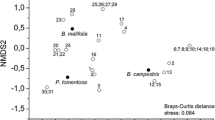Abstract
In tropical dry and hot forests, flower-visiting bees are able to forage only during the few hours a day with mild temperatures, but they may chose more freely among the plant species to be visited. Therefore, we tested the hypothesis that the overlap in temporal niches should be higher than the overlap in trophic niches among these bees. Between pairs of species (Schoener index), the overlap in trophic niches varied from 0.007 to 0.745, whereas the temporal overlap varied from 0.062 to 0.865. In general, the trophic overlap was low, with 79 % of the species pairs scoring below 30 %, and the temporal overlap varied from moderate to high. At the community level, the observed overlap in trophic niches was higher than expected by chance, both for diet and foraging time. The network analysis confirmed at the community level that bees separate more strongly their trophic (E = 0.82) than their temporal niches (E = 0.50).



Similar content being viewed by others
References
Aguiar, C.M.L., Santos, G.M.M. (2007) Compartilhamento de recursos florais por vespas sociais (Hymenoptera: Vespidae) e abelhas (Hymenoptera: Apoidea) em uma área de caatinga. Neotrop. Entomol. 36, 836–842
Araújo, M.S., Guimarães Jr., P.R., Svanbäck, R., Pinheiro, A., Guimarães, P., Reis, S.F., Bolnick, D.I. (2008) Network analysis reveals contrasting effects of intraspecific competition on individual vs. population diets. Ecology 89, 1981–1993
Araújo, M.S., Martins, E.G., Cruz, L.D., Fernandes, F.R., Linhares, A.X., Reis, S.F., Guimaraes, P.R. (2010) Nested diets: a novel pattern of individual-level resource use. Oikos 119, 81–88
Bascompte, J., Jordano, P. (2007) The structure of plant–animal mutualistic networks: the architecture of biodiversity. Annu. Rev. Ecol. Evol. Syst. 38, 567–593
Behmer, S.T., Joern, A. (2008) Coexisting generalist herbivores occupy unique nutritional feeding niches. Proc. Natl. Acad. Sci. U. S. A. 105, 1977–1982
Blondel, J. (2003) Guilds or functional groups: does it matter? Oikos 100, 223–231
Costa, L.F., Rodrigues, F.A., Travieso, G., Villas Boas, P.R. (2007) Characterization of complex networks: a survey of measurements. Adv. Phys. 56, 167–242
Dormann, C.F., Fründ, J., Blüthgen, N., Gruber, B. (2009) Indices, graphs and null models: analyzing bipartite ecological networks. Open Ecol. J. 2, 7–24
Feinsinger, P., Spears, E.E., Poole, R.W. (1981) A simple measure of niche breadth. Ecology 62, 27–32
Gause, G.F. (1934) The struggle for existence. Williams & Wilkins, Baltimore
Gottlieb, D., Keasar, T., Shmida, A., Motro, U. (2005) Possible foraging benefits of bimodal daily activity in Proxylocopa olivieri (Lepeletier) (Hymenoptera: Anthophoridae). Environ. Entomol. 34, 417–424
Hairston, N.G. (1984) Inferences and experimental results in guild structure. In: Strong, D.R., Simberloff, D., Abele, L.G., Thistle, A.B. (eds.) Ecological communities: Conceptual issues and the evidence, pp. 23–27. Princeton University Press, Princeton
Hölldobler, B., Wilson, E.O. (1990) The ants. Harvard University Press, Cambridge
Liebold, M.A. (1997) Similarity and local co-existence of species in regional biotas. Evol. Ecol. 29, 95–110
Pianka, E.R. (1973) The structure of lizard communities. Annu. Rev. Ecol. Evol. Syst. 4, 53–74
Pianka, E.R. (1980) Guild structure in desert lizards. Oikos 35, 194–201
Presley, S.J., Willig, M.R., Castro-Arellano, I., Weaver, S.C. (2009) Effects of habitat conversion on temporal activity patterns of phyllostomid bats in lowland Amazonian rain forest. J. Mammal. 90, 210–221
Root, R.B. (1967) The niche exploitation pattern of the blue-gray gnatcatcher. Ecol. Monogr. 37, 317–350
Sakagami, S., Laroca, S.F., Moure, J.S. (1967) Wild bee biocenotics in São José dos Pinhais (PR), south Brazil. J. Fac. Sci., Hokkaido Univ., Ser. VI, Zoology 16, 253–291
Santos, G.M.M., Aguiar, C.M.L., Mello, M.A.R. (2010) Flower-visiting guild associated with the Caatinga flora: trophic interaction networks formed by social bees and social wasps with plants. Apidologie 41, 466–475
Schoener, T.W. (1986) Resource partitioning. In: Kikkawa, J., Anderson, D.J. (eds.) Community ecology—pattern and process, pp. 91–126. Blackwell Scientific, London
Stone, G.N., Gilbert, F., Willmer, P., Potts, S., Semida, F., Zalat, S. (1999) Windows of opportunity and the temporal structuring of foraging activity in a desert solitary bee. Ecol. Entomol. 24, 208–221
Thomson, D.M. (2006) Detecting the effects of introduced species: a case study of competition between Apis and Bombus. Oikos 114, 407–418
Vasconcellos, A., Ricardo, A., Almeida, A.M., Araujo, H.F.P., Oliveira, E.S., Oliveira, U. (2010) Seasonality of insects in the semi-arid Caatinga of northeastern Brazil. Revta. bras Ent. 54, 471–476
Willmer, P., Stone, G. (1997) Temperature and water relations in desert bees. J. Therm. Biol. 22, 453–465
Wilms, W., Imperatriz-Fonseca, V.L., Wolf, E. (1996) Resource partitioning between highly eusocial bees and possible impact of the introduced Africanized honey bee on native stingless bees in the Brazilian rain forest. Stud. Neotropical Fauna Environ. 31, 137–151
Acknowledgments
We thank Dr. Luciano Paganucci de Queiroz (UEFS) who identified the plants. The Brazilian Research Council (CNPq) and the Research Foundation of Bahia (FAPESB) funded this project. CNPq granted research productivity fellowships to GMM Santos and CAL Carvalho. The Alexander von Humboldt Foundation granted a postdoctoral fellowship (no. 1134644) to MAR Mello.
Author information
Authors and Affiliations
Corresponding author
Additional information
Manuscipt Editor: Marina Meixner
Chevauchement des niches trophique et temporelle dans une guilde d’abeilles (Hymenoptera, Apoidea), visitant les fleurs d’une forêt sèche tropicale
Niche trophique/ niche temporelle/ Apoidea/ Caatinga/
Überlappung von trophischen und zeitlichen Nischen in der blütenbesuchenden Bienengilde (Hymenoptera, Apoidea) eines tropischen Trockenwalds
Trophische Nische/ zeitliche Nische/ Nischenüberlappung/ Bienengilde/Apoidea
Rights and permissions
About this article
Cite this article
de M. Santos, G.M., de Carvalho, C.A.L., Aguiar, C.M.L. et al. Overlap in trophic and temporal niches in the flower-visiting bee guild (Hymenoptera, Apoidea) of a tropical dry forest. Apidologie 44, 64–74 (2013). https://doi.org/10.1007/s13592-012-0155-8
Received:
Revised:
Accepted:
Published:
Issue Date:
DOI: https://doi.org/10.1007/s13592-012-0155-8




